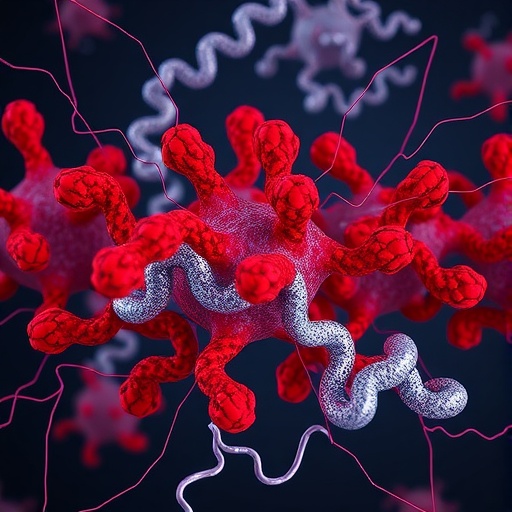In a groundbreaking advancement in malaria research, scientists have unveiled a novel technique that maps protein interactions within the malaria parasite Plasmodium falciparum throughout its complex intraerythrocytic developmental cycle (IDC). This development promises to illuminate the dynamic protein networks underpinning the parasite’s survival and virulence, offering profound insights that could accelerate the quest for new antimalarial therapies.
Plasmodium falciparum, the deadliest of malaria-causing parasites, navigates a multifaceted lifecycle inside human red blood cells — a stage known as the intraerythrocytic developmental cycle. This cycle entails sequential transformations between ring, trophozoite, and schizont stages over roughly 48 hours, during which the parasite dramatically reshapes its proteome to adapt, proliferate, and evade host defenses. Central to these processes are protein complexes, intricately assembled molecular machines whose composition and interactions orchestrate critical cellular functions.
Traditionally, mapping protein–protein interactions in P. falciparum has relied heavily on ex vivo methods, extracting parasite proteins for biochemical analyses outside their native cellular context. Though informative, these approaches do not capture the full complexity or the temporal dynamics of interactions occurring within living cells. Such limitations have hindered the detailed understanding of how malaria protein complexes dynamically reorganize during distinct blood stages.
Addressing this challenge, Pazicky, Tjia, Farias and colleagues have developed MAP-X (meltome-assisted profiling of protein complexes), an innovative methodology that integrates thermal proteome profiling with intact cell systems to chart the P. falciparum complexome with unprecedented resolution. MAP-X leverages the principle that protein complexes exhibit temperature-dependent stability — by incrementally heating intact parasitized red blood cells and monitoring thermal unfolding patterns of proteins via mass spectrometry, the technique infers physical associations and complex compositions in situ.
Applying MAP-X across seven discrete timepoints within the IDC, the researchers generated a comprehensive temporal map encompassing over 20,000 predicted protein–protein interactions. This concerted effort not only recapitulated previously reported complexes but also uncovered a plethora of novel associations, revealing an intricate and dynamic landscape of malaria protein interactions.
Among the most striking revelations was the observation that malaria protein complexes undergo stage-specific alterations, reshuffling their subunit composition and interaction strength as the parasite progresses through its developmental trajectory. These dynamic rearrangements likely underpin essential biological transitions such as nutrient acquisition, immune evasion, and merozoite formation — processes vital for parasite propagation and host infection.
Moreover, the MAP-X data illuminated a fascinating phenomenon dubbed “moonlighting” subunits: protein components that transiently dissociate from their canonical complexes to assume alternative, distinct biological functions elsewhere within the cell. This finding suggests an additional layer of regulatory complexity in malaria biology, where multifunctional proteins contribute fluidly to diverse cellular machineries, fine-tuning parasite adaptability.
The authors also demonstrated that MAP-X could successfully delineate conserved protein complexes shared across eukaryotic species, reaffirming the method’s robustness and providing comparative frameworks for functional annotation. This cross-species perspective is invaluable for pinpointing parasite-specific adaptations that could serve as selective drug targets while sparing human host pathways.
Technically, the success of MAP-X hinges on two key innovations: maintaining parasite integrity during thermal profiling to preserve native complexes, and employing sophisticated computational pipelines for data deconvolution and interaction prediction. By integrating quantitative proteomics with thermal stability assessments, the approach transcends limitations of static protein isolation, enabling dynamic, context-dependent complexome profiling in living cells.
The implications of this work extend far beyond malaria research. MAP-X offers a versatile platform to interrogate protein complex dynamics across varied biological contexts and organisms, potentially illuminating molecular underpinnings of diseases characterized by dysregulated protein interactions. In malaria specifically, the capacity to capture stage-resolved complex interactions opens a new frontier for rational drug design targeting transient yet critical protein assemblies.
Importantly, MAP-X addresses a critical knowledge gap in the temporal dimension of parasite biology. Previous interactomic studies largely provided static snapshots; now, with dynamic profiling, researchers can observe how complexes assemble, disassemble, and reconfigure in real time, a nuance essential for deciphering functional states and vulnerabilities of the parasite.
Furthermore, this study sets the stage for integrating MAP-X with complementary approaches such as single-cell proteomics and cryo-electron microscopy, fostering a holistic understanding of P. falciparum molecular physiology. Such integrative multi-omics frameworks could unravel previously intractable questions about parasite differentiation, persistence, and drug resistance emergence.
The discovery of moonlighting subunits is particularly tantalizing. Multifunctional proteins complicate the canonical one gene–one function paradigm, suggesting malaria parasites employ sophisticated molecular economy strategies to maximize functional diversity from limited genomic resources. Targeting moonlighting proteins might disrupt multiple pathways simultaneously, a strategy with high therapeutic potential.
In conclusion, the introduction of MAP-X represents a transformative advance in the molecular parasitology toolkit. By mapping the elusive and shifting architecture of protein complexes in intact Plasmodium falciparum cells, this approach propels malaria research into a dynamic, systems-level era. As we push closer to eradicating malaria, technologies like MAP-X will be pivotal in unveiling novel biological insights and informing next-generation interventions tailored to disrupt parasite survival mechanisms at their molecular core.
The road from comprehensive protein interaction maps to druggable targets is long, yet the groundwork laid by Pazicky and colleagues provides an indispensable roadmap. With malaria annually afflicting hundreds of millions worldwide and exacting enormous human and economic tolls, innovations in understanding parasite biology at this scale offer hope for breakthroughs that can save lives and reshape global health landscapes.
Subject of Research: The dynamic protein complex interactions within Plasmodium falciparum during its intraerythrocytic developmental cycle.
Article Title: MAP-X reveals distinct protein complex dynamics across Plasmodium falciparum blood stages.
Article References: Pazicky, S., Tjia, S., Farias, G.B. et al. MAP-X reveals distinct protein complex dynamics across Plasmodium falciparum blood stages. Nat Microbiol (2025). https://doi.org/10.1038/s41564-025-02173-7
Image Credits: AI Generated




